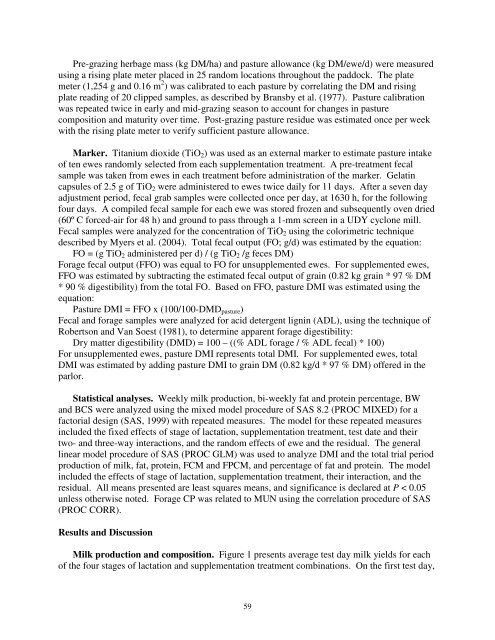great lakes dairy sheep symposium - the Department of Animal ...
great lakes dairy sheep symposium - the Department of Animal ...
great lakes dairy sheep symposium - the Department of Animal ...
You also want an ePaper? Increase the reach of your titles
YUMPU automatically turns print PDFs into web optimized ePapers that Google loves.
Pre-grazing herbage mass (kg DM/ha) and pasture allowance (kg DM/ewe/d) were measured<br />
using a rising plate meter placed in 25 random locations throughout <strong>the</strong> paddock. The plate<br />
meter (1,254 g and 0.16 m 2 ) was calibrated to each pasture by correlating <strong>the</strong> DM and rising<br />
plate reading <strong>of</strong> 20 clipped samples, as described by Bransby et al. (1977). Pasture calibration<br />
was repeated twice in early and mid-grazing season to account for changes in pasture<br />
composition and maturity over time. Post-grazing pasture residue was estimated once per week<br />
with <strong>the</strong> rising plate meter to verify sufficient pasture allowance.<br />
Marker. Titanium dioxide (TiO2) was used as an external marker to estimate pasture intake<br />
<strong>of</strong> ten ewes randomly selected from each supplementation treatment. A pre-treatment fecal<br />
sample was taken from ewes in each treatment before administration <strong>of</strong> <strong>the</strong> marker. Gelatin<br />
capsules <strong>of</strong> 2.5 g <strong>of</strong> TiO2 were administered to ewes twice daily for 11 days. After a seven day<br />
adjustment period, fecal grab samples were collected once per day, at 1630 h, for <strong>the</strong> following<br />
four days. A compiled fecal sample for each ewe was stored frozen and subsequently oven dried<br />
(60º C forced-air for 48 h) and ground to pass through a 1-mm screen in a UDY cyclone mill.<br />
Fecal samples were analyzed for <strong>the</strong> concentration <strong>of</strong> TiO2 using <strong>the</strong> colorimetric technique<br />
described by Myers et al. (2004). Total fecal output (FO; g/d) was estimated by <strong>the</strong> equation:<br />
FO = (g TiO2 administered per d) / (g TiO2 /g feces DM)<br />
Forage fecal output (FFO) was equal to FO for unsupplemented ewes. For supplemented ewes,<br />
FFO was estimated by subtracting <strong>the</strong> estimated fecal output <strong>of</strong> grain (0.82 kg grain * 97 % DM<br />
* 90 % digestibility) from <strong>the</strong> total FO. Based on FFO, pasture DMI was estimated using <strong>the</strong><br />
equation:<br />
Pasture DMI = FFO x (100/100-DMDpasture)<br />
Fecal and forage samples were analyzed for acid detergent lignin (ADL), using <strong>the</strong> technique <strong>of</strong><br />
Robertson and Van Soest (1981), to determine apparent forage digestibility:<br />
Dry matter digestibility (DMD) = 100 – ((% ADL forage / % ADL fecal) * 100)<br />
For unsupplemented ewes, pasture DMI represents total DMI. For supplemented ewes, total<br />
DMI was estimated by adding pasture DMI to grain DM (0.82 kg/d * 97 % DM) <strong>of</strong>fered in <strong>the</strong><br />
parlor.<br />
Statistical analyses. Weekly milk production, bi-weekly fat and protein percentage, BW<br />
and BCS were analyzed using <strong>the</strong> mixed model procedure <strong>of</strong> SAS 8.2 (PROC MIXED) for a<br />
factorial design (SAS, 1999) with repeated measures. The model for <strong>the</strong>se repeated measures<br />
included <strong>the</strong> fixed effects <strong>of</strong> stage <strong>of</strong> lactation, supplementation treatment, test date and <strong>the</strong>ir<br />
two- and three-way interactions, and <strong>the</strong> random effects <strong>of</strong> ewe and <strong>the</strong> residual. The general<br />
linear model procedure <strong>of</strong> SAS (PROC GLM) was used to analyze DMI and <strong>the</strong> total trial period<br />
production <strong>of</strong> milk, fat, protein, FCM and FPCM, and percentage <strong>of</strong> fat and protein. The model<br />
included <strong>the</strong> effects <strong>of</strong> stage <strong>of</strong> lactation, supplementation treatment, <strong>the</strong>ir interaction, and <strong>the</strong><br />
residual. All means presented are least squares means, and significance is declared at P < 0.05<br />
unless o<strong>the</strong>rwise noted. Forage CP was related to MUN using <strong>the</strong> correlation procedure <strong>of</strong> SAS<br />
(PROC CORR).<br />
Results and Discussion<br />
Milk production and composition. Figure 1 presents average test day milk yields for each<br />
<strong>of</strong> <strong>the</strong> four stages <strong>of</strong> lactation and supplementation treatment combinations. On <strong>the</strong> first test day,<br />
59
















